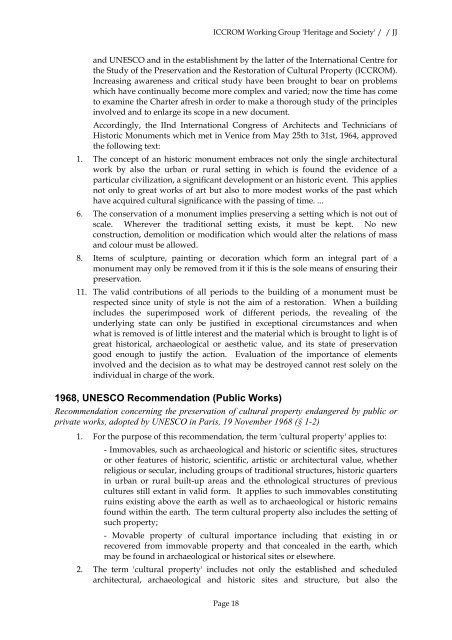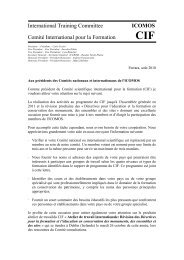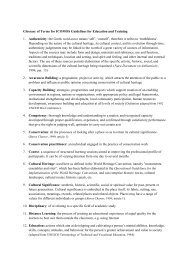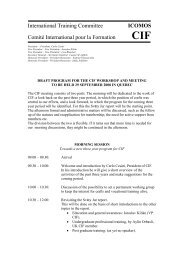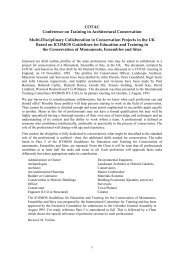Definition of Cultural Heritage -- References to ... - CIF - Icomos
Definition of Cultural Heritage -- References to ... - CIF - Icomos
Definition of Cultural Heritage -- References to ... - CIF - Icomos
You also want an ePaper? Increase the reach of your titles
YUMPU automatically turns print PDFs into web optimized ePapers that Google loves.
ICCROM Working Group '<strong>Heritage</strong> and Society' / / JJ<br />
and UNESCO and in the establishment by the latter <strong>of</strong> the International Centre for<br />
the Study <strong>of</strong> the Preservation and the Res<strong>to</strong>ration <strong>of</strong> <strong>Cultural</strong> Property (ICCROM).<br />
Increasing awareness and critical study have been brought <strong>to</strong> bear on problems<br />
which have continually become more complex and varied; now the time has come<br />
<strong>to</strong> examine the Charter afresh in order <strong>to</strong> make a thorough study <strong>of</strong> the principles<br />
involved and <strong>to</strong> enlarge its scope in a new document.<br />
Accordingly, the IInd International Congress <strong>of</strong> Architects and Technicians <strong>of</strong><br />
His<strong>to</strong>ric Monuments which met in Venice from May 25th <strong>to</strong> 31st, 1964, approved<br />
the following text:<br />
1. The concept <strong>of</strong> an his<strong>to</strong>ric monument embraces not only the single architectural<br />
work by also the urban or rural setting in which is found the evidence <strong>of</strong> a<br />
particular civilization, a significant development or an his<strong>to</strong>ric event. This applies<br />
not only <strong>to</strong> great works <strong>of</strong> art but also <strong>to</strong> more modest works <strong>of</strong> the past which<br />
have acquired cultural significance with the passing <strong>of</strong> time. ...<br />
6. The conservation <strong>of</strong> a monument implies preserving a setting which is not out <strong>of</strong><br />
scale. Wherever the traditional setting exists, it must be kept. No new<br />
construction, demolition or modification which would alter the relations <strong>of</strong> mass<br />
and colour must be allowed.<br />
8. Items <strong>of</strong> sculpture, painting or decoration which form an integral part <strong>of</strong> a<br />
monument may only be removed from it if this is the sole means <strong>of</strong> ensuring their<br />
preservation.<br />
11. The valid contributions <strong>of</strong> all periods <strong>to</strong> the building <strong>of</strong> a monument must be<br />
respected since unity <strong>of</strong> style is not the aim <strong>of</strong> a res<strong>to</strong>ration. When a building<br />
includes the superimposed work <strong>of</strong> different periods, the revealing <strong>of</strong> the<br />
underlying state can only be justified in exceptional circumstances and when<br />
what is removed is <strong>of</strong> little interest and the material which is brought <strong>to</strong> light is <strong>of</strong><br />
great his<strong>to</strong>rical, archaeological or aesthetic value, and its state <strong>of</strong> preservation<br />
good enough <strong>to</strong> justify the action. Evaluation <strong>of</strong> the importance <strong>of</strong> elements<br />
involved and the decision as <strong>to</strong> what may be destroyed cannot rest solely on the<br />
individual in charge <strong>of</strong> the work.<br />
1968, UNESCO Recommendation (Public Works)<br />
Recommendation concerning the preservation <strong>of</strong> cultural property endangered by public or<br />
private works, adopted by UNESCO in Paris, 19 November 1968 (§ 1-2)<br />
1. For the purpose <strong>of</strong> this recommendation, the term 'cultural property' applies <strong>to</strong>:<br />
- Immovables, such as archaeological and his<strong>to</strong>ric or scientific sites, structures<br />
or other features <strong>of</strong> his<strong>to</strong>ric, scientific, artistic or architectural value, whether<br />
religious or secular, including groups <strong>of</strong> traditional structures, his<strong>to</strong>ric quarters<br />
in urban or rural built-up areas and the ethnological structures <strong>of</strong> previous<br />
cultures still extant in valid form. It applies <strong>to</strong> such immovables constituting<br />
ruins existing above the earth as well as <strong>to</strong> archaeological or his<strong>to</strong>ric remains<br />
found within the earth. The term cultural property also includes the setting <strong>of</strong><br />
such property;<br />
- Movable property <strong>of</strong> cultural importance including that existing in or<br />
recovered from immovable property and that concealed in the earth, which<br />
may be found in archaeological or his<strong>to</strong>rical sites or elsewhere.<br />
2. The term 'cultural property' includes not only the established and scheduled<br />
architectural, archaeological and his<strong>to</strong>ric sites and structure, but also the<br />
Page 18


